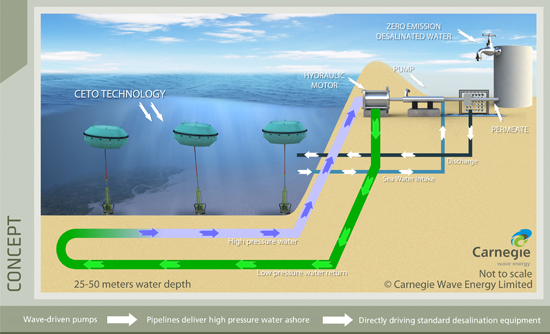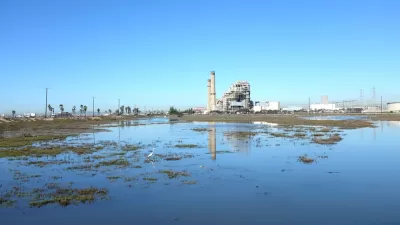The future has arrived in Western Australia thanks to new technology created and implemented by Carnegie Wave Energy. The CETO project marries renewable power with desalination—a timely marriage when droughts and climate change take center stage.
"In one of the country’s biggest infrastructure projects in its history, Australia’s five largest cities are spending $13.2 billion on desalination plants capable of sucking millions of gallons of seawater from the surrounding oceans every day, removing the salt and yielding potable water," writes Amy Yee of The New York Times.
One of the biggest challenges is to how to supply the energy while creating the lowest carbon footprint. That's where Carnegie Wave Energy's renewable power comes into play.

"Named after the Greek sea goddess, CETO technology produces zero-emission electricity by using submerged buoys tethered to seabed pumps, which drive hydroelectric turbines via high-pressure water through a subsea pipe," writes William Yeoman of The West Australian. They buoys create the energy by harnessing the waves, causing them to go up and down.
"In late February, the buoys started supplying 240 kilowatts each to the electricity grid at HMAS Stirling, Australia’s largest naval base," writes Yee. "They also help run a desalination plant that transforms seawater into about one-third of the base’s fresh water supply."
"The potential energy in the ocean's waves globally is twice what the world currently consumes, so there is enormous potential for wave energy," states Carnegie Wave Energy boss Michael Ottaviano. [The West Australian].
If you're unsure as to how the bobbing of the buoys creates energy, The Economist has an excellent diagram and description in their March article on the project.
Hat tip: Loren Spiekerman
FULL STORY: Catching Waves and Turning Them Into Electricity

Planetizen Federal Action Tracker
A weekly monitor of how Trump’s orders and actions are impacting planners and planning in America.

Restaurant Patios Were a Pandemic Win — Why Were They so Hard to Keep?
Social distancing requirements and changes in travel patterns prompted cities to pilot new uses for street and sidewalk space. Then it got complicated.

Maui's Vacation Rental Debate Turns Ugly
Verbal attacks, misinformation campaigns and fistfights plague a high-stakes debate to convert thousands of vacation rentals into long-term housing.

In California Battle of Housing vs. Environment, Housing Just Won
A new state law significantly limits the power of CEQA, an environmental review law that served as a powerful tool for blocking new development.

Boulder Eliminates Parking Minimums Citywide
Officials estimate the cost of building a single underground parking space at up to $100,000.

Orange County, Florida Adopts Largest US “Sprawl Repair” Code
The ‘Orange Code’ seeks to rectify decades of sprawl-inducing, car-oriented development.
Urban Design for Planners 1: Software Tools
This six-course series explores essential urban design concepts using open source software and equips planners with the tools they need to participate fully in the urban design process.
Planning for Universal Design
Learn the tools for implementing Universal Design in planning regulations.
Heyer Gruel & Associates PA
JM Goldson LLC
Custer County Colorado
City of Camden Redevelopment Agency
City of Astoria
Transportation Research & Education Center (TREC) at Portland State University
Camden Redevelopment Agency
City of Claremont
Municipality of Princeton (NJ)





























